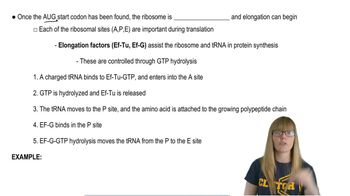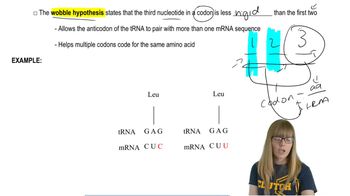Table of contents
- 1. Introduction to Genetics51m
- 2. Mendel's Laws of Inheritance3h 37m
- 3. Extensions to Mendelian Inheritance2h 41m
- 4. Genetic Mapping and Linkage2h 28m
- 5. Genetics of Bacteria and Viruses1h 21m
- 6. Chromosomal Variation1h 48m
- 7. DNA and Chromosome Structure56m
- 8. DNA Replication1h 10m
- 9. Mitosis and Meiosis1h 34m
- 10. Transcription1h 0m
- 11. Translation58m
- 12. Gene Regulation in Prokaryotes1h 19m
- 13. Gene Regulation in Eukaryotes44m
- 14. Genetic Control of Development44m
- 15. Genomes and Genomics1h 50m
- 16. Transposable Elements47m
- 17. Mutation, Repair, and Recombination1h 6m
- 18. Molecular Genetic Tools19m
- 19. Cancer Genetics29m
- 20. Quantitative Genetics1h 26m
- 21. Population Genetics50m
- 22. Evolutionary Genetics29m
11. Translation
Translation
Problem 18
Textbook Question
After completing Problem 17, carefully draw a line below the mRNA to represent its polypeptide product in accurate alignment with the mRNA. Label the N-terminal and C-terminal ends of the polypeptide. Carefully draw two lines above and parallel to the mRNA, and label them 'coding strand' and 'template strand.' Locate the DNA promoter sequence. Identify the locations of the nucleotide and of a transcription termination sequence.
 Verified step by step guidance
Verified step by step guidance1
Identify the mRNA sequence from Problem 17 and note its 5' to 3' direction.
Draw a line below the mRNA sequence to represent the polypeptide chain, aligning each codon with its corresponding amino acid.
Label the N-terminal (amino end) at the start of the polypeptide and the C-terminal (carboxyl end) at the end.
Draw two lines above the mRNA: one for the 'coding strand' (5' to 3') and one for the 'template strand' (3' to 5').
Locate the DNA promoter sequence upstream of the mRNA start site and identify the transcription termination sequence downstream.
Recommended similar problem, with video answer:
 Verified Solution
Verified SolutionThis video solution was recommended by our tutors as helpful for the problem above
Video duration:
1mPlay a video:
Was this helpful?
Key Concepts
Here are the essential concepts you must grasp in order to answer the question correctly.
Transcription
Transcription is the process by which the genetic information encoded in DNA is copied into messenger RNA (mRNA). This occurs in the nucleus of eukaryotic cells, where RNA polymerase binds to the promoter region of a gene, unwinding the DNA and synthesizing a complementary RNA strand. Understanding transcription is crucial for accurately representing the relationship between DNA and mRNA in the context of gene expression.
Recommended video:
Guided course

Eukaryotic Transcription
Polypeptide Structure
A polypeptide is a chain of amino acids linked by peptide bonds, which is synthesized during translation based on the sequence of codons in mRNA. The polypeptide has distinct ends: the N-terminal (amino end) and the C-terminal (carboxyl end), which are important for its function and folding. Recognizing these structural features is essential for accurately labeling the polypeptide product derived from the mRNA.
Recommended video:
Guided course

Ribosome Structure
DNA Strands
In the context of transcription, DNA consists of two strands: the coding strand and the template strand. The coding strand has the same sequence as the mRNA (except for thymine being replaced by uracil), while the template strand is complementary to the mRNA and serves as the actual template for RNA synthesis. Identifying these strands is vital for understanding how genetic information is transcribed and how the promoter and termination sequences function in this process.
Recommended video:
Guided course

Double Strand Breaks

 7:58m
7:58mWatch next
Master Translation initiation with a bite sized video explanation from Kylia Goodner
Start learning




